英语语法形容词和副词
- 格式:doc
- 大小:60.50 KB
- 文档页数:8
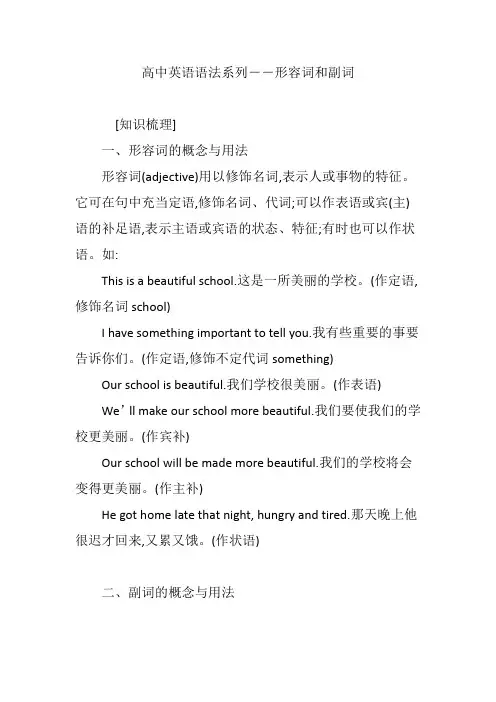
高中英语语法系列――形容词和副词[知识梳理]一、形容词的概念与用法形容词(adjective)用以修饰名词,表示人或事物的特征。
它可在句中充当定语,修饰名词、代词;可以作表语或宾(主)语的补足语,表示主语或宾语的状态、特征;有时也可以作状语。
如:This is a beautiful school.这是一所美丽的学校。
(作定语,修饰名词school)I have something important to tell you.我有些重要的事要告诉你们。
(作定语,修饰不定代词something)Our school is beautiful.我们学校很美丽。
(作表语)We’ll make our school more beautiful.我们要使我们的学校更美丽。
(作宾补)Our school will be made more beautiful.我们的学校将会变得更美丽。
(作主补)He got home late that night, hungry and tired.那天晚上他很迟才回来,又累又饿。
(作状语)二、副词的概念与用法副词(adverb)用以修饰动词、形容词或其它副词。
它在句中主要作状语,个别副词也可作表语、定语、或宾(主)语补足语。
He studies hard.他学习很努力。
(作状语,修饰动词)I’m terribly sorry for being late. 非常抱歉,我迟到了。
(作状语,修饰形容词)This coat fits him very well.这件上衣他穿着很合适。
(作状语,修饰副词)The people here are kind to us.这里的人对我们很好。
(作定语,修饰The people)When will you be back? 你什么时候回来?(作表语)三、形容词与副词的转换有的形容词加上ly后可转换成副词,规则如下:注意:friendly, motherly, lovely等词虽然以ly结尾,但不是副词,而是形容词。

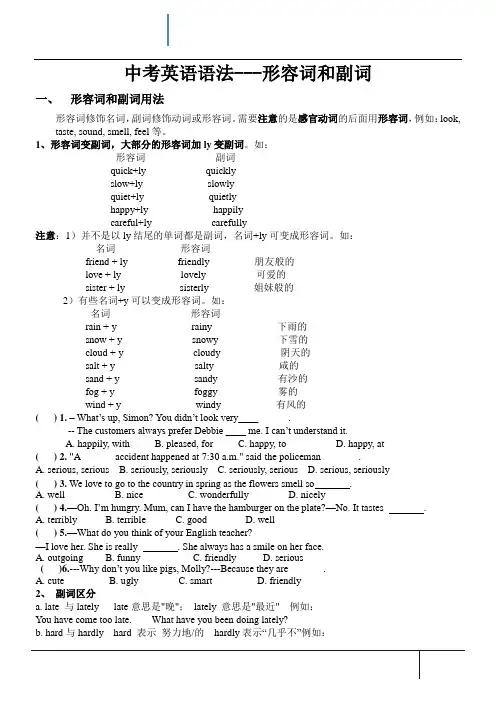
中考英语语法---形容词和副词一、形容词和副词用法形容词修饰名词,副词修饰动词或形容词。
需要注意的是感官动词的后面用形容词,例如:look, taste, sound, smell, feel等。
1、形容词变副词,大部分的形容词加ly变副词。
如:形容词副词quick+ly quicklyslow+ly slowlyquiet+ly quietlyhappy+ly happilycareful+ly carefully注意:1)并不是以ly结尾的单词都是副词,名词+ly可变成形容词。
如:名词形容词friend + ly friendly 朋友般的love + ly lovely 可爱的sister + ly sisterly 姐妹般的2)有些名词+y可以变成形容词。
如:名词形容词rain + y rainy 下雨的snow + y snowy 下雪的cloud + y cloudy 阴天的salt + y salty 咸的sand + y sandy 有沙的fog + y foggy 雾的wind + y windy 有风的( ) 1.–What’s up, Simon? You didn’t look very____ .-- The customers always prefer Debbie ____ me. I can’t understand it.A. happily, withB. pleased, forC. happy, toD. happy, at( ) 2. "A ______ accident happened at 7:30 a.m." said the policeman _______.A. serious, seriousB. seriously, seriouslyC. seriously, seriousD. serious, seriously( ) 3. We love to go to the country in spring as the flowers smell so .A. wellB. niceC. wonderfullyD. nicely( ) 4.—Oh. I’m hungry. Mum, can I have the hamburger on the plate?—No. It tastes .A. terriblyB. terribleC. goodD. well( ) 5.—What do you think of your English teacher?—I love her. She is really . She always has a smile on her face.A. outgoingB. funnyC. friendlyD. serious( )6.---Why don’t you like pigs, Molly?---Because they are ______ .A. cuteB. uglyC. smartD. friendly2、副词区分a. late 与lately late意思是"晚";lately 意思是"最近" 例如:You have come too late. What have you been doing lately?b. hard与hardly hard 表示努力地/的hardly表示―几乎不‖例如:he works hard. I can hardly finish it in a week.c. close与closely close意思是"近";closely 意思是"仔细地" 例如:He is sitting close to me. Watch him closely.d. deep与deeply deep意思是"深"表示空间深度;deeply时常表示感情上的深度,"深深地" 例如:He pushed the stick deep into the mud. Even father was deeply moved by the movie.e. high与highly high表示空间高度;highly表示程度,相当于much 例如The plane was flying high. I think highly of your opinion.f. wide与widely wide表示空间宽度;widely意思是"广泛地","在许多地方" 例如:He opened the door wide. English is widely used in the world.( ) 1 Mingming got up very _______,so he came to school half an hour ______.te; latelyB. lately; lateC. lately; latelyD. late; late二、形容词与副词的原级、比较级和最高级1、形容词和副词有比较级和最高级的变化大多数形容词(性质形容词)和副词有比较级和最高级的变化,即原级、比较级和最高级,用来表示事物的等级差别。

形容词和副词一、形容词和副词的作用1.形容词(adj.)修饰名词形容词(adj.)修饰名词时,有两种位置:1紧挨着被修饰的名词,做定语。
例:This is a wonderful world.(形容词wonderful修饰名词world)We are now living in a beautiful new house.(形容词beautiful和new修饰名词house)2置于系动词之后,做表语。
例:Their sleeping bags were warm and comfortable.(形容词warm和comfortable修饰名词sleeping bags)2.副词(adv.)修饰动词、句子、其他的形容词或副词例:Roy acted quickly.(副词quickly修饰动词act)Suddenly,one of the children kicked a ball.(副词suddenly修饰整个句子)It rained continually and it was often bitterly cold.(1.副词continually修饰动词rain;2.副词bitterly修饰形容词cold)The students from elite universities catch up very quickly.(1.副词quickly修饰动词catch up;2.副词very修饰另一个副词quickly)备注:一般情况下,形容词后加“ly”,就变成对应的副词。
例如:happy-happi ly、angry-angri ly、rude-rude ly。
例:生气的男孩生气地喊。
→The angry boy shouted angrily.二、形容词和副词的比较级形容词和副词的比较级分为:1)最高级(最...)2)比较级(更...)3)原级比较(一样...)1.形容词/副词的最高级:the+adj./adv.的最高级(+介词短语,表示比较的范围)“(...范围内)最...”,通常用于三者或以上的比较例:My younger sister is the tallest one in her class.(最高级变化形式:adj./adv.+est)The most serious problem of the project is the lack of power.(最高级变化形式:adj./adv.前加the most)注意:the+adj./adv.的最高级(+in+地点、场所)the+adj./adv.的最高级(+of+比较的对象)例:He is the tallest in our class.He is the tallest of all the students.练习:1)Which is the longest river____the world?2)This is the finest picture____them all.3)This stereo is the most expensive____all the ones in the shop.4)He is the best boxer____our town.答案:in;of;of;in2.形容词/副词的比较级:adj./adv.的比较级(+than+比较的对象)“(和...相比)更...”通常用于两者之间的比较例:I am taller than you.(比较级变化形式:adj./adv.+er)Air tickets are more expensive than train tickets.(比较级变化形式:adj./adv.前加more)Sometimes machines can perform better than human beings.(good比较级的不规则变化:better)注意:比较的对象要一致。
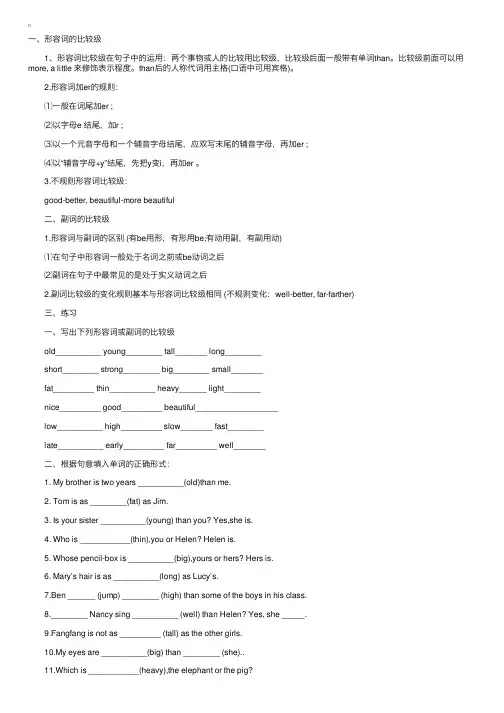
⼀、形容词的⽐较级 1、形容词⽐较级在句⼦中的运⽤:两个事物或⼈的⽐较⽤⽐较级,⽐较级后⾯⼀般带有单词than。
⽐较级前⾯可以⽤more, a little 来修饰表⽰程度。
than后的⼈称代词⽤主格(⼝语中可⽤宾格)。
2.形容词加er的规则: ⑴⼀般在词尾加er ; ⑵以字母e 结尾,加r ; ⑶以⼀个元⾳字母和⼀个辅⾳字母结尾,应双写末尾的辅⾳字母,再加er ; ⑷以“辅⾳字母+y”结尾,先把y变i,再加er 。
3.不规则形容词⽐较级: good-better, beautiful-more beautiful ⼆、副词的⽐较级 1.形容词与副词的区别 (有be⽤形,有形⽤be;有动⽤副,有副⽤动) ⑴在句⼦中形容词⼀般处于名词之前或be动词之后 ⑵副词在句⼦中最常见的是处于实义动词之后 2.副词⽐较级的变化规则基本与形容词⽐较级相同 (不规则变化:well-better, far-farther) 三、练习 ⼀、写出下列形容词或副词的⽐较级 old__________ young________ tall_______ long________ short________ strong________ big________ small_______ fat_________ thin__________ heavy______ light________ nice_________ good_________ beautiful__________________ low__________ high_________ slow_______ fast________ late__________ early_________ far_________ well_______ ⼆、根据句意填⼊单词的正确形式: 1. My brother is two years __________(old)than me. 2. Tom is as ________(fat) as Jim. 3. Is your sister __________(young) than you? Yes,she is. 4. Who is ___________(thin),you or Helen? Helen is. 5. Whose pencil-box is __________(big),yours or hers? Hers is. 6. Mary’s hair is as __________(long) as Lucy’s. 7.Ben ______ (jump) ________ (high) than some of the boys in his class. 8.________ Nancy sing __________ (well) than Helen? Yes, she _____. 9.Fangfang is not as _________ (tall) as the other girls. 10.My eyes are __________(big) than ________ (she).. 11.Which is ___________(heavy),the elephant or the pig? 12.Who gets up _________(early),Tim or Tom? 13._____the girls get up_______(early) than the boys?No,they______. 14. Jim runs _____(slow). But Ben runs _____(slow). 15.The child doesn’t______(write) as ____(fast) as the students. 三、翻译句⼦: 1、谁⽐Jim年纪⼤?是你。



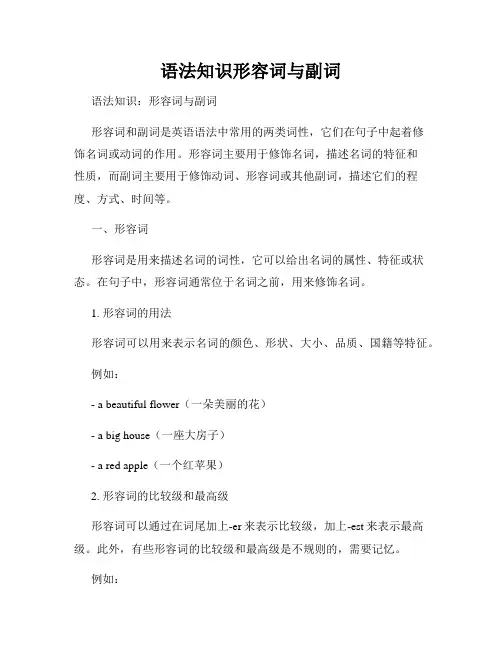
语法知识形容词与副词语法知识:形容词与副词形容词和副词是英语语法中常用的两类词性,它们在句子中起着修饰名词或动词的作用。
形容词主要用于修饰名词,描述名词的特征和性质,而副词主要用于修饰动词、形容词或其他副词,描述它们的程度、方式、时间等。
一、形容词形容词是用来描述名词的词性,它可以给出名词的属性、特征或状态。
在句子中,形容词通常位于名词之前,用来修饰名词。
1. 形容词的用法形容词可以用来表示名词的颜色、形状、大小、品质、国籍等特征。
例如:- a beautiful flower(一朵美丽的花)- a big house(一座大房子)- a red apple(一个红苹果)2. 形容词的比较级和最高级形容词可以通过在词尾加上-er来表示比较级,加上-est来表示最高级。
此外,有些形容词的比较级和最高级是不规则的,需要记忆。
例如:- tall(高)- taller(更高)- tallest(最高)- good(好)- better(更好)- best(最好)3. 形容词的位置形容词通常放在名词前面,但有时也可以放在名词后面。
例如:- a beautiful girl(一个漂亮的女孩)- a girl beautiful(一个漂亮的女孩)二、副词副词是一类用来修饰动词、形容词或其他副词的词性。
它可以表示时间、地点、方式、程度等含义。
1. 副词的用法副词可以用来修饰动词,表示动作发生的方式、频率、时间等。
例如:- He speaks slowly.(他说话慢慢地)- She always arrives on time.(她总是准时到达)副词还可用来修饰形容词,表示程度或程度的变化。
例如:- The weather is very hot today.(今天天气非常热)- She is quite tall.(她很高)2. 副词的比较级和最高级副词的比较级和最高级形式通常在词尾加上-er和-est,但也有一些不规则变化的副词。

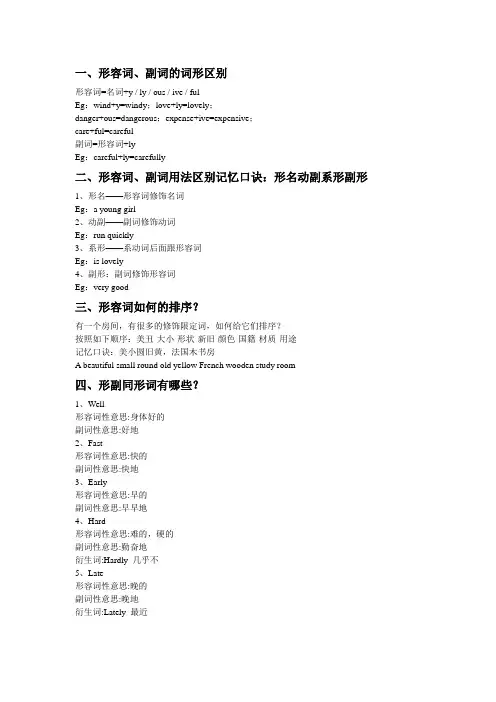
一、形容词、副词的词形区别形容词=名词+y / ly / ous / ive / fulEg:wind+y=windy;love+ly=lovely;danger+ous=dangerous;expense+ive=expensive;care+ful=careful副词=形容词+lyEg:careful+ly=carefully二、形容词、副词用法区别记忆口诀:形名动副系形副形1、形名——形容词修饰名词Eg:a young girl2、动副——副词修饰动词Eg:run quickly3、系形——系动词后面跟形容词Eg:is lovely4、副形:副词修饰形容词Eg:very good三、形容词如何的排序?有一个房间,有很多的修饰限定词,如何给它们排序?按照如下顺序:美丑-大小-形状-新旧-颜色-国籍-材质-用途记忆口诀:美小圆旧黄,法国木书房A beautiful small round old yellow French wooden study room四、形副同形词有哪些?1、Well形容词性意思:身体好的副词性意思:好地2、Fast形容词性意思:快的副词性意思:快地3、Early形容词性意思:早的副词性意思:早早地4、Hard形容词性意思:难的,硬的副词性意思:勤奋地衍生词:Hardly 几乎不5、Late形容词性意思:晚的副词性意思:晚地衍生词:Lately 最近6、Near形容词性意思:近的副词性意思:近地衍生词:Nearly 几乎7、High形容词性意思:高的副词性意思:高地衍生词:Highly 高度地五、比较级和最高级词的比较级和最高级变化规则。
腾飞辅导中心小学英语语法(第22期)第三讲形容词和副词Name Mark★重点讲解一、形容词:形容词是用来修饰物体的形状、大小、长度、属性、特点的词。
1.一般位于名词前,做“ 前置定语” 。
I have a busy day. 我忙了一天。
She is a famous scientist.2.放在be动词的后面,被称为“ 系表结构” 。
如:He is clever. She is beautiful.3.当几个形容词或形容词和名词同时修饰一个名词时,必须按照正确的排列顺序,即:大小--- 形状--- 颜色--- 质地。
如:a big yellow banana a white round stone bench4.表示国籍的几个形容词,还可以用作名词,但意义上有所区别。
如:a Chinese /Japanese boy speak Chinese / Japanese5.形容词修饰不定代词something, anything等时,需要置于其后。
如:I have something important to tell you.There is something wrong with you.二、副词:是说明时间、地点、程度、方式等概念的词。
1.副词的分类时间副词如:now, usually, often, always, sometime, yesterday等。
地点副词如:here, there, everywhere等。
(其前不能加介词,如:go there / come here)方式副词如:quiet ly, slow ly,quick ly, careful ly等。
(““怎样地” )程度副词如:very, much, quite(完全地,十分地), too(太)等。
2.副词的用法:主要用来修饰动词的。
如:He play s basketball well.He jump s high.三、形容词、副词的等级:原级、比较级和最高级。
英语语法之形容词、副词一、定义:形容词是用来修饰和形容名词,说明人与事物性质和特征的词。
副词是用来修饰动词、形容词、副词或整个句子。
二、比较级和最高级的构成方法:1.单音节词和少数双音节词比较级和最高级的规则变化:2. 其他双音节词或多音节词,在该词前面加-more/mostbeautiful—more beautiful—(the) most beautiful3. 由形容词加ly构成的双音节词和多音节词,都是在该词前加-more/most.quickly—more quickly—(the) most quicklydifficultly—more difficultly—(the) most difficultly4. 不规则变化:不规则变化记忆口诀:特殊形式比较级,共有三对二合一。
病坏两多并两好,little意少不是小。
一分为二也三个,距离老远常迟到。
三、形容词比较级和最高级的用法:1. 原级的用法:用于两者之间对比,意思为“……和……相同”A+v.+as….+形容词原级+as BTom is as honest as Jack.2.比较级的用法:①A+形容词比较级+than+ BBeijing is more beautiful than Tianjin.形容词比较级前还可以用much, even, still, a little,far, a lot, a bit, much more来修饰,very, so, too, quite 不能修饰比较级。
②数字+形容词比较级+thanI’m two years older than you.She is a head taller than me.③比较级+and+比较级,表示“越来越……”The earth is getting warmer and warmer.China becomes more and more stronger.④the +比较级,the +比较级结构,表示“越……就越……”The more I study it, the more I like it.⑤which/who +is +比较级Which city is bigger, Beijing or Tianjin?Who is happier, you or me?3. 最高级用法:用于三者及以上的人或事物的比较,最高级前加the,后面跟带in或of表范围的短语。
4.形容词和副词4.1 形容词及其用法形容词修饰名词,说明事物或人的性质或特征。
通常,可将形容词分成性质形容词和叙述形容词两类,其位置不一定都放在名词前面。
1)直接说明事物的性质或特征的形容词是性质形容词,它有级的变化,可以用程度副词修饰,在句中可作定语、表语和补语。
例如:hot 热的。
2)叙述形容词只能作表语,所以又称为表语形容词。
这类形容词没有级的变化,也不可用程度副词修饰。
大多数以a开头的形容词都属于这一类。
例如:afraid 害怕的。
(错)He is an ill man.(对)The man is ill.(错)She is an afraid girl.(对)The girl is afraid.这类词还有:well,unwell,ill,faint,afraid,alike,alive,alone,asleep,awake 等。
3)形容词作定语修饰名词时,要放在名词的前边。
但是如果形容词修饰以-thing为字尾的词语时,要放在这些词之后,例如:something nice4.2 以-ly结尾的形容词1)大部分形容词加-ly可构成副词。
但friendly,deadly,lovely,lonely,likely,lively,ugly,brotherly,仍为形容词。
改错:(错)She sang lovely.(错)He spoke to me very friendly.(对)Her singing was lovely.(对)He spoke to me in a very friendly way.2)有些以-ly 结尾既为形容词,也为副词。
daily,weekly,monthly,yearly,earlyThe Times is a daily paper.The Times is published daily.4.3 用形容词表示类别和整体1)某些形容词加上定冠词可以泛指一类人,与谓语动词的复数连接。
形容词和副词的区别是什么在英语语法中,形容词和副词是两种常见的词性。
它们在句子中扮演不同的角色,并且有着不同的用法和功能。
本文将详细介绍形容词和副词的区别。
1. 定义和用途形容词是一类用来修饰名词或代词的词,用以描述名词的特征、性质或状态。
形容词通常用于名词前作定语,用来限定或修饰名词。
例如:a beautiful flower(一朵美丽的花)。
副词是一类用来修饰动词、形容词、副词或整个句子的词,用以表示行为的方式、程度、频率、时间等。
副词可以修饰整个句子,也可以修饰其他词性的词。
例如:She runs quickly.(她跑得快)2. 修饰对象形容词主要修饰名词,用来描述或限定名词的属性或特征。
形容词通常放在名词前面,也可以放在系动词之后作表语。
例如:a tall building(一座高楼);The book is interesting.(这本书很有趣)副词主要修饰动词、形容词或其他副词,用来描述或修饰这些词的程度或方式。
副词可以放在句子中的不同位置,具体位置取决于所修饰的词。
例如:She speaks loudly.(她大声说话);He drives very slowly.(他开车非常慢)3. 形态变化形容词的形态变化相对较为固定,通常有三个级别:原级(表示基本的属性或状态)、比较级(表示相对程度的比较)和最高级(表示最高程度的比较)。
形容词的比较级和最高级往往通过在词尾加-er和-est来构成,也可以在形容词前面加more和most来构成。
例如:big (大)- bigger(更大)- biggest(最大);beautiful(美丽的)- more beautiful(更美丽的)- most beautiful(最美丽的)副词的形态变化相对简单,大多数副词只有一个形态,不进行比较级和最高级的变化。
一些副词也可以通过在词尾加-er和-est来构成比较级和最高级。
若副词与形容词形态相同,则需要在词前加副词修饰词,如more或most。
形容词和副词形容词及其用法形容词修饰名词,说明事物或人的性质或特征。
通常,可将形容词分成性质形容词和叙述形容词两类,其位置不一定都放在名词前面。
1)直接说明事物的性质或特征的形容词是性质形容词,它有级的变化,可以用程度副词修饰,在句中可作定语、表语和补语。
例如:hot 热的。
2)叙述形容词只能作表语,所以又称为表语形容词。
这类形容词没有级的变化,也不可用程度副词修饰。
大多数以a开头的形容词都属于这一类。
例如:afraid 害怕的。
(错)He is an ill man.(对)The man is ill.(错)She is an afraid girl.(对)The girl is afraid.这类词还有:well,unwell,ill,faint,afraid,alike,alive,alone,asleep,awake 等。
3)形容词作定语修饰名词时,要放在名词的前边。
但是如果形容词修饰以-thing为字尾的词语时,要放在这些词之后,例如:something nice形容词及其用法形容词修饰名词,说明事物或人的性质或特征。
通常,可将形容词分成性质形容词和叙述形容词两类,其位置不一定都放在名词前面。
1)直接说明事物的性质或特征的形容词是性质形容词,它有级的变化,可以用程度副词修饰,在句中可作定语、表语和补语。
例如:hot 热的。
2)叙述形容词只能作表语,所以又称为表语形容词。
这类形容词没有级的变化,也不可用程度副词修饰。
大多数以a开头的形容词都属于这一类。
例如:afraid 害怕的。
(错)He is an ill man.(对)The man is ill.(错)She is an afraid girl.(对)The girl is afraid.这类词还有:well,unwell,ill,faint,afraid,alike,alive,alone,asleep,awake 等。
3)形容词作定语修饰名词时,要放在名词的前边。
但是如果形容词修饰以-thing为字尾的词语时,要放在这些词之后,例如:something nice以-ly结尾的形容词1)大部分形容词加-ly可构成副词。
但friendly,deadly,lovely,lonely,likely,lively,ugly,brotherly,仍为形容词。
改错:(错)She sang lovely.(错)He spoke to me very friendly.(对)Her singing was lovely.(对)He spoke to me in a very friendly way.2)有些以-ly 结尾既为形容词,也为副词。
daily,weekly,monthly,yearly,earlyThe Times is a daily paper.The Times is published daily.用形容词表示类别和整体1)某些形容词加上定冠词可以泛指一类人,与谓语动词的复数连接。
如:the dead,the living,the rich,the poor,the blind,the hungryThe poor are losing hope.2)有关国家和民族的形容词加上定冠词指这个民族的整体,与动词的复数连用。
the British,the English,the French,the Chinese.The English have wonderful sense of humor.多个形容词修饰名词的顺序多个形容词修饰名词时,其顺序为:限定词--数词--描绘词--(大小,长短,形状,新旧,颜色) --出处--材料性质,类别--名词a small round tablea tall gray buildinga dirty old brown shirta famous German medical schoolan expensive Japanese sports car典型例题:1)Tony is going camping with ___ boys.A.little two otherB. two little otherC.two other littleD.little other two答案:C。
由"限定词--数词--描绘词--(大小,长短,形状,新旧,颜色) --性质--名词"的公式可知数词,描绘词,性质依次顺序,只有C符合答案。
2)One day they crossed the ____bridge behind the palace.A. old Chinese stoneB. Chinese old stoneC. old stone ChineseD. Chinese stone old答案A. 几个形容词修饰一个名词,他们的排列顺序是:年龄,形状,大小+颜色+来源+质地+用途+国家+名词。
3) ---- How was your recent visit to Qingdao?---- It was great. We visited some friends,and spent the ___days at the seaside.A. few last sunnyB. last few sunnyC. last sunny fewD. few sunny last答案:B。
本题考查多个形容词的排序问题。
一般与被修饰形容词关系密切的形容词靠近名词;如果几个形容词的重要性差不多,音节少的形容词在前,音节多的方在后,在不能确定时,可参照下表:限定词+数量词(序数词在前,基数词在后)+性状形容词+大小、长短、高低等形体+ those + three + beautiful + large + square新旧+颜色+国籍+材料+名词old + brown + wood + table副词及其基本用法副词主要用来修饰动词,形容词,副词或其他结构。
一、副词的位置:1)在动词之前。
2)在be动词、助动词之后。
3)多个助动词时,副词一般放在第一个助动词后。
注意:a. 大多数方式副词位于句尾,但宾语过长,副词可以提前,以使句子平衡。
We could see very clearly a strange light ahead of us.b. 方式副词well,badly糟、坏,hard等只放在句尾。
He speaks English well.二、副词的排列顺序:1)时间,地点副词,小单位的在前,大单位在后。
2)方式副词,短的在前,长的在后,并用and或but等连词连接。
Please write slowly and carefully.3)多个不同副词排列:程度+地点+方式+时间副词。
注意:副词very 可以修饰形容词,但不能修饰动词。
改错:(错)I very like English.(对)I like English very much.注意:副词enough要放在形容词的后面,形容词enough放在名词前后都可。
I don't know him well enough.There is enough food for everyone to eat.There is food enough for everyone to eat.兼有两种形式的副词1) close与closelyclose意思是"近";closely 意思是"仔细地"He is sitting close to me.Watch him closely.2)late 与latelylate意思是"晚";lately 意思是"最近"You have come too late.What have you been doing lately?3)deep与deeplydeep意思是"深",表示空间深度;deeply时常表示感情上的深度,"深深地"He pushed the stick deep into the mud.Even father was deeply moved by the film.4)high与highlyhigh表示空间高度;highly表示程度,相当于muchThe plane was flying high.I think highly of your opinion.5)wide与widelywide表示空间宽度;widely意思是"广泛地","在许多地方"He opened the door wide.English is widely used in the world.6)free与freelyfree的意思是"免费";freely 的意思是"无限制地"You can eat free in my restaurant whenever you like.You may speak freely; say what you like.形容词与副词的比较级大多数形容词(性质形容词)和副词有比较级和最高级的变化,即原级、比较级和最高级,用来表示事物的等级差别。
原级即形容词的原形,比较级和最高级有规则变化和不规则变化两种。
1) 规则变化单音节词和少数双音节词,加词尾-er,-est来构成比较级和最高级。
构成法原级比较级最高级一般单音节词tall(高的)taller tallest未尾加-er,-est great(巨大的)greater greatest以不发音的e结尾nice(好的)nicer nicest的单音词和少数large(大的)larger largest以- le结尾的双able(有能力的) abler ablest音节词只加-r,-st以一个辅音字母big(大的)bigger biggest结尾的闭音节单hot热的)hotter hottest音节词,双写结尾的辅音字母,再加-er,-est"以辅音字母+y"easy(容易的)easier easiest结尾的双音节词,busy(忙的)busier busiest改y为i,再加-er,-est少数以-er,-ow clever(聪明的)cleverer cleverest结尾的双音节词narrow(窄的)narrower narrowest未尾加-er,-est其他双音节词和important(重要的)多音节词,在前more important面加more,most most important来构成比较级和easily(容易地)最高级。